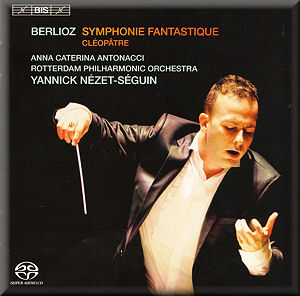 |
 |
|


alternatively
CD: MDT
AmazonUK
AmazonUS
BIS Downloads available from eclassical.com |
Hector BERLIOZ (1803-1869)
Symphonie fantastique, Op. 14/H. 48 (1830) [54:30]
Cléopâtre, scène lyrique, H. 36 (1829) [19:44]
 Anna Caterina Antonacci (soprano)
Anna Caterina Antonacci (soprano)
Rotterdam Philharmonic Orchestra/Yannick Nézet-Séguin
rec. March 2009, Studio MCO5, Music Centre for Dutch Radio and Television,
Hilversum, The Netherlands. DDD
 BIS-SACD-1800
BIS-SACD-1800  [75:05]
[75:05] 
|
|
|
The French-Canadian conductor Yannick Nézet-Séguin only appeared
on my radar a few months ago, when I heard his debut concert
with the Berliner Philharmoniker. It was a revelation for two
reasons: first, their performance of the Symphonie fantastique
was electric, one of the best I’ve heard in years; and second,
it introduced me to the BP’s Digital Concert Hall, which streams
concerts straight to one’s PC or television – with glorious
pictures and sound. That performance was filmed in October 2010,
eighteen months after this BIS/Rotterdam Philharmonic recording
was made; Nézet-Séguin had already been appointed the Dutch
band’s principal conductor in 2006, a contract that has since
been extended to 2015.
Watching that Berlin concert – more than once, I might add –
I was most impressed by this young conductor’s energy and vision.
Not surprisingly, I leapt at the chance to review this BIS release,
made more attractive by the fact that it’s an SACD. It’s not
the only Super Audio version of this symphony – there are about
twenty in the catalogue, including PentaTone’s re-mastering
of Sir Colin Davis’s Concertgebouw account from 1974 – but Nézet-Séguin’s
certainly seems one of the most promising.
The half-lit world of ‘Rêveries-Passions’ is usually a good
indicator of which way the symphony will go, and on that basis
the mannered surge and retreat of Nézet-Séguin’s reading is
a major disappointment. Moreover, that all-important inner tension
– which Davis conveys so well – is missing. The result is a
curiously spasmodic account of this music, not helped by a low-level
recording that isn’t up to the standards I expect from BIS.
Where is that sense of space and air, of a wide, deep soundstage
on which this drama is played out in all its lurid detail?
As for the phrasing of ‘Un bal’, it’s scarcely an improvement,
the opening chatter of strings devoid of its usual strangeness.
Indeed, that’s true of the movement as a whole; if these are
the hero’s opiate-fuelled fantasies then they’re dull indeed.
True, the Rotterdam orchestra play well enough, but they don’t
sound particularly engaged; it’s all so ordinary, and that’s
not what one wants to hear in this wild, gaudy work. There’s
no delirium in the waltz either, Nézet-Séguin opting for underpowered
elegance rather than overcharged imaginings.
The ‘Scène aux champs’ suffers from the same stop-go approach,
phrases enclosed in parentheses as it were. And that’s one reason
why the growing sense of unease – of which the approaching storm
is a powerful metaphor – is not even glimpsed, let alone realised.
I’ve rarely heard this music chug so, or found it so aimless.
In mitigation, there is some lovely playing here, but
in such an amorphous reading it doesn’t count for much. All
I can say is, what a difference eighteen months – and another
band – makes, for Nézet-Séguin’s taut, colourful Berlin performance
is a world away from this flaccid affair.
That doesn’t bode well for the grotesque ‘Marche au supplice’
and ‘Songe d’une nuit de Sabbat’; and so it proves, for this
is where the performance really comes unstuck. Nézet-Séguin
is much too controlled – and controlling – in the wild-eyed
procession, the swaying rhythms sounding curiously foursquare.
One need look no further than Davis to find a propulsive energy,
a pent-up tension, that’s only released with the fall of that
cruel blade. And if you’re hoping for a spooky Walpurgisnacht
of a finale you’ll be sorely disappointed. Again there’s some
fine playing, but what one really wants here is swathes of colour
applied with a broad brush, not fastidious attention to detail.
Cléopâtre, better known as La mort de Cléopâtre,
is sung well enough; soprano Anna Caterina Antonacci certainly
has an impressive range – she sounds more like a mezzo at times
– but her distinct vibrato is an acquired taste. That said,
Nézet-Séguin’s expressive underlinings and propensity to swoop
and swoon is much more distracting. The wonderful Dame Janet
Baker – with Sir Alexander Gibson on EMI and Sir Colin Davis
on Philips – is still unmatched in terms of vocal characterisation
and sheer dramatic intensity.
One needs to remember that recordings – like performances –
are photographs, mere snapshots of specific, unrepeatable events.
Clearly, Nézet-Séguin the conductor has come a long way since
that first picture – as his Berlin concert testifies – and despite
my disappointment I still think he’s one to watch. As for the
recording itself, I can hardly believe this is the same label
and venue that produced the huge dynamics we hear in Mark Wigglesworth’s
Shostakovich cycle. The Super Audio layer on this Berlioz issue
really needs to be cranked up before it comes into focus, but
even then it doesn’t sound much better than an average Red Book
CD. One can only hope Nézet-Séguin and BIS will be snapped in
more flattering light some time soon.
Dan Morgan
|
|

